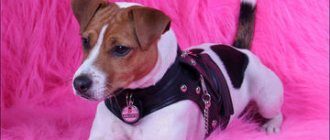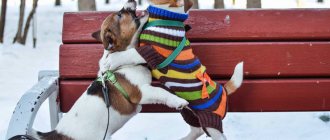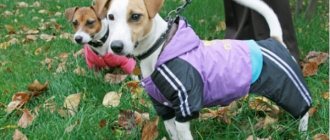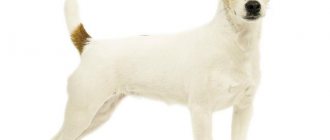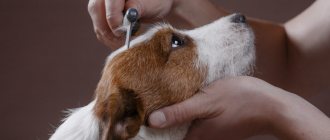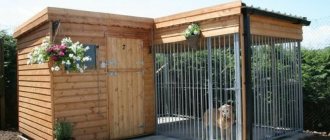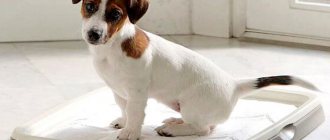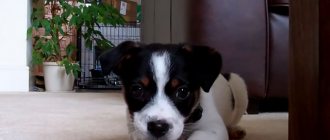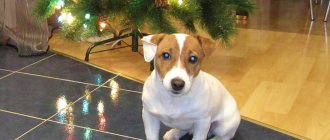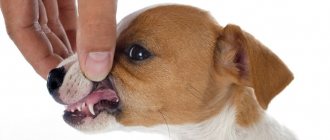Jack Russell Terriers are one of the smartest dog breeds.
They are always on the move, both at home and on the street. Therefore, despite the presence of undercoat, which means they are not very cold, they need clothing for protection. In autumn and spring from mud and water, when the dog rushes through puddles. And in winter, most dogs living in apartments need to be dressed.
Their body is not adapted to negative temperatures. To purchase an outfit for your pet or create one yourself, you need to correctly measure the size of your dog’s clothing.
How to choose
First you need to take all measurements from your pet. The suit itself should be made of durable and waterproof material to protect the dog from getting wet. A winter outfit should have a warm lining inside to protect against the cold. Most often it is made from fleece. And the outer part is made of nylon.
The suit should not have crooked seams or protruding threads. And even more so it should not be defective. The Jack Russell Terrier is an active dog that loves to run and jump regardless of the time of year. And the pet should feel comfortable in a suit, and not vice versa.
How to take measurements correctly, choosing material
About taking measurements from an animal
For this purpose, measurements should be taken. Designing an outfit, modeling like people
Requires perseverance, attention and drawing skills
Taking measurements
Rules for taking measurements:
- Measurements of the animal are made in a “standing” position.
- Volumes are measured taking into account the width margin.
- If it is not possible to clarify the measured parameters (they fluctuate), then you should choose a larger value.
- The size is selected taking into account the modeling of clothing.
- The choice should be based on the length of the animal’s back.
- To determine the volume of the chest, the dog's chest is measured (more precisely, the widest part plus 2-4 centimeters is measured, taking into account the loose fit).
- The volume of the neck is determined (corresponds to the size of the collar).
- The back length is the length of the spine (the distance between the neck and the base of the tail).
Important! The main parameter when taking measurements is the length of the animal’s back
About the choice of material
The constructed pattern is transferred to the fabric from which clothing for the animal will be made. A crucial moment is the choice of material and accessories present in dog clothing models:
- lightning;
- fasteners;
- Velcro;
- finishing tapes;
- rubber bands
A variety of ribbons Material should be selected taking into account seasonality. On a hot summer day - no overheating, the animal should breathe freely. On cool days, clothing is essential to retain body heat. Therefore, natural fabrics are used, primarily cotton.
Inclement, rainy weather brings dampness, taking this into account, clothes are made from waterproof fabrics (Bologna, raincoat fabrics). For dressing “underneath”, wool and cotton jumpers, suits, sweaters are suitable, which you can knit yourself.
In frost and snow, the animal is saved from the cold by coats made of drape, wool, faux fur, fleece, padding polyester.
Choosing a Collar
There are certain rules, subject to which your pet will feel comfortable in a collar:
- two fingers of your hand should fit freely between the dog’s neck and the collar;
- the collar should be so wide that it cannot be removed over the head;
- The collar should not restrict movement or put pressure. The dog should turn and tilt its head freely;
- The collar should be made of a material that does not chafe the skin. Check the material, feel it, is it soft enough?
IMPORTANT!
It is advisable to choose a collar, like a harness, by trying it on the dog. This way you can better assess whether the accessory hinders your pet’s movements.
We are trying to study popular types of shoes for small breeds
In addition to clothing, in winter small breed dogs also need shoes to protect their paws from glass shards, debris and chemicals that are sprinkled on city streets. Shoes, like clothes, can easily be made from old things, such as a woolen jacket. The sole is usually made from genuine leather, suede or other waterproof materials. Winter shoes are usually lined with fur, padding polyester, fleece or other insulating materials. In order for the boots to stay securely on the paws, Velcro, buckles, and elastic bands are used.
As an example, I suggest looking at a few photos with shoe options for your pets, which you can make yourself:
- When sewing shoes, the main thing is not to allow the elastic bands to put too much pressure on the limbs, otherwise blood circulation will be disrupted and the paws will quickly freeze. To create a shoe pattern, you need to put the dog on a sheet of paper, outline the paws (note that the front and rear limbs are different in size) and add 10 - 12mm for a loose fit.
- Today on the Internet there are a large number of sites offering free downloads of clothing and shoe patterns for dogs of various breeds. On the one hand, this is very convenient - you don’t need to bother with drawings. It is enough to print out the pattern and start sewing, but such ready-made drawings, as a rule, do not take into account the characteristics of an individual dog and it may happen that the downloaded pattern will not suit your pet.
- In any case, regardless of whether you download a ready-made pattern or draw it yourself, making clothes for your dog with your own hands will allow you not only to dress your pet in comfortable clothes, but also to create his individual wardrobe, which will not be similar to any other dogs.
As an example, I offer several photographs with original clothes for dogs:
How to determine size
Before purchasing, the owner must take all necessary measurements of the dog. Some manufacturers indicate the breed-size ratio. However, focusing on it is risky - the outfit may turn out to be small or large. When choosing clothes, you should proceed only from the measurements of the pet itself.
Taking measurements is quite simple. To do this, you need to measure the circumference of the neck along the line of the collar, the volume of the chest just behind the front paws and the length along the back from the base of the neck (withers) to the tail. For shoes, measure the length and width of the paw. The dog's paw is placed on a white sheet of paper, circled and the above parameters are measured.
After taking all the measurements, you can start ordering an outfit or going to the pet store.
Step-by-step sewing instructions
If we consider the step-by-step instructions with the materials listed above on how to sew a thing, it looks like this:
- Measure the animal’s body and make a pattern for the dog’s overalls according to your own ideas;
Creating a pattern
- Sew the edges of the parts together, insert the elastic into the cuffs with a collar and sew in a zipper;
Ready product
- Decorate the product with various accessories to suit your taste.
As for decoration, you can additionally make a hood. It is not necessary to sew it tightly; you can make it removable. To form a suit, you need to measure the circumference of the head and ears, make a pattern, insert an elastic band into the finished product and sew it to the finished garment. Additionally, you can make a pocket on the side. It is imperative to make a hole for the discharge and cut a hole for the tail, having previously measured the diameter of the corresponding compartment.
You might consider making a onesie with completely closed paws, or come up with detachable shoes with an elastic band, like children's mittens, with a snap or button.
Detachable jumpsuit
The specifics of how a dog's outfit will be created completely depend on the gender of the dog.
This is why it is so important to choose the appropriate sewing instructions. The following scheme is suitable for both large four-legged friends and small Spitz or other species
The resulting clothing can be used as a regular raincoat. If you add a comfortable pad to it, your pet will feel comfortable wearing it in winter. All you need is:
- Take measurements, cut the material to start sewing;
- Sew the hood to the back of the throat, additionally inserting an elastic band;
- Place the visor so that it is later convenient for the dog, process it along the curved edge;
- Overlap the straight edge of the visor and sew the visor to the front of the hood;
- Sew up the belly with the side elements of the future product;
- Sew the cuff parts and pull the elastic bands over them.
Pattern for sewing a stylish jumpsuit
Interestingly, for such a product you can combine several different materials with each other, creating a kind of sporty design. You can also add an inscription on the back, but only after all the work is done.
Additionally, you can decorate the created product with glow-in-the-dark elements. This will be very useful for owners during a night or evening walk. It is also possible to make a jumpsuit with detachable parts. Then it will look more like a suit with a jacket and pants. But in terms of ease of putting on and taking off, this product will be better.
Features of tailoring
What should you pay special attention to when sewing clothes for a dog? Of course, safety, comfort and practicality.
Remember that the dog is active and clothes should not interfere with it. Add 2-3 cm to the pattern, not counting seam allowances. Things for a boy should be shorter across the stomach than for a girl, due to his physiological characteristics.
When choosing fabric or yarn, give preference to natural materials or at least 50% natural fibers (wool, cotton). Clothes should be cleaned and washed well, dry quickly, and should not be ironed.
Fasteners should be as secure as possible - Velcro and zippers. Choose plastic snakes with large links. Be sure to make a bar under the zipper to prevent dog hair from getting into the zipper. All decorative elements must be firmly sewn or glued.
Where to begin
You need to start by studying some of the features of clothing for dogs. If you devote enough time to this, as a master, there will be no price for you. In pet stores today there is quite a wide selection of different models of clothing for dogs, but most often they are sewn without taking into account the anatomy and some of the features of our smaller brothers. For example, a jumpsuit designed for a long-haired dog should not have elastic bands on the legs (they tangle the hair), the hood on the jacket should not have ties, preferably buttons or Velcro - there are quite a lot of such little things.
To understand everything, look through “dog” forums, topics about clothes
Just not those where they sell, but those where the owners discuss the things they bought, pay attention to what they praise and what they are dissatisfied with
Non-professional seamstresses, when creating clothes for their own pets, often share patterns on the Internet; you can also download several books with tips on cutting and sewing clothes for dogs, with ready-made models and step-by-step instructions on how to make them. The more of this material you have on hand, the better. When you gain experience, you will create clothing models yourself; it is not as difficult as it seems. But for starters, ready-made pattern diagrams will be very useful to you. You can improve your skills by sewing several different models of clothes for the dogs of your relatives or friends; they will probably be happy to help you, and in return they will receive a cool thing as a gift.
Results
Harsh weather conditions, living in large cities where reagents are scattered every winter force Jack Russell Terrier owners to think about purchasing a warm suit. Clothing will prevent the pet from getting severe frostbite, will protect it from gusty winds and rain, and shoes will prevent the influence of reagents on the paw pads. The question of buying an outfit is individual: some dogs, especially long-haired breeds, easily survive the winter, for others frosts turn into a serious problem.
DIY overalls for dogs
For a small dog, clothing is not a whim of the owner, but a justified necessity. Such breeds are not adapted to temperature changes; animals freeze when walking in the cool season. In summer, clothing will protect the animal from dangerous insect bites and ticks. Let's look at how to sew overalls for a dog yourself.
Sew for Yorkie
The basic pattern of clothes for a dog looks like this.
We take measurements and adjust the basic pattern. In our master class, the back part is sewn from parts.
After adjustments we get a working version of the pattern.
For sewing we will prepare:
- fabric - main and lining;
- accessories;
- threads, sewing accessories.
Description
We lay out the patterns on the fabric and cut them out taking into account the specified allowances.
We sew the parts from the main fabric with a backstitch.
We sew the lining fabric parts with a regular seam.
We fold the main and lining parts with the wrong sides facing each other.
We process the sections with bias tape or make a hem with stitching.
We install buttons, sew elastic band and cuffs onto the neck. The jumpsuit is ready!
We knit ourselves
You don’t have to buy all these things in stores - you can knit clothes for dogs with your own hands. This will require very few items and a little patience and skill.
What you need
What do you need to knit a sweater for a dog? Not as much as it might seem. Tools:
- knitting needles or crochet hook;
- scissors;
- rubber;
- threads;
- centimeter, pen and piece of paper for taking measurements;
- needle.
This is probably all that is needed in addition to the yarn already purchased. But knitting threads are a separate matter. The choice of yarn will be entirely up to you and depend on the purpose for which the sweater is knitted. The main qualities that threads must have are:
- naturalness;
- the ability to ensure good thermoregulation (in cold weather - warm, in warm weather - do not overheat the pet);
- convenience.
Therefore, avoid purchasing synthetic yarn that is scratchy. For a summer version of a blouse, you can buy cotton threads. For the winter, you can knit a sweater made of mohair, wool and acrylic for your pet.
Avoid cheap, low-quality yarn, especially those made in China. It may contain harmful substances that can cause allergies.
Instructions - how to knit a sweater
How to knit a sweater for a dog? The following instructions will help beginners.
- Work should begin by taking measurements. For dogs of the same breed, standard measurements may be suitable, which can be found in the master classes provided on the Internet. But still, in order for the product to fit well, it is best to make the measurements yourself. You need to know the following parameters: leg girth, back and tummy length, chest girth.
- The first step is to determine the knitting density for each specific yarn. To do this, knit a small sample of the selected pattern with knitting needles and count how many loops fit into 1 cm.
- Now count the number of loops based on the dog’s measurements. For example, by multiplying the number of loops per 1 cm circumference of the chest, we find out how many of them there will be in this part of the sweater.
- When knitting a sweater for a dog, you always start with the collar. In this part of the garment, the number of loops should be less than in the chest circumference. Therefore, from the number of loops in the girth, subtract 20 pieces (for small dogs) and 30 for larger ones. Cast on the resulting number of stitches onto the needles.
- Let's start knitting the neckline. Divide the total number of stitches cast on by 5. Knit the first and last part with an elastic band 1*1, and knit the rest with stockinette stitch.
- Where you knitted with satin stitch, you will begin to create rows for the back, and where with an elastic band - for the tummy. In every second row, add loops to expand. At the same time, those that are added from the elastic side are included in its pattern, and those that are knitted are knitted in satin stitch. In this way we knit 10 rows (you get 5 increments of 4 loops each) for the Yorkshire Terrier, for the Jack Russell - 16 rows.
- Don't forget about the holes for the legs - they need to be made approximately 5-7 cm from the starting row. They are easy to knit: on the front row, knit 3-5 elastic loops, close them, then knit 3-5 stitches with satin stitch. Now knit all the satin stitches except the last 3-5 and bind them off. Close the elastic loops, knit the last 3-5 loops according to the pattern.
- Then, on the purl row, cast on air stitches in an amount equal to the closed loops in the previous row. In the next front row, knit the cast-on loops with an elastic band.
- Now knit the sweater to the very end of the tummy. Don’t forget to gradually make decreases so that the blouse narrows and the belly of the finished product does not hang. To do this, in every 8 row, 2 loops (adjacent satin stitch and elastic) are knitted together. Where the tummy ends, transfer the elastic loops to separate knitting needles and now knit only the back stitch.
- We knit the bottom of the blouse with an elastic band - about 6-8 rows.
- The sweater knitted by hand is almost ready, now all that remains is to sew its details along the edge loops.
Preparing the pattern
So, let's begin our master class on making a standard overalls for a dog of any breed of small or medium size. First, let's prepare a pattern on paper, which we will later use to transfer measurements to the fabric. In fact, sewing overalls for dogs with your own hands is not that difficult. Well, if we knit, then we should enjoy the process!
The standard pattern for sewing a warm overall looks the same for small, medium and large breeds. Its description is easy to find on the Internet; it can be built on a computer or done manually. If you prefer the second option, then to do this you need to take a sheet of paper or graph paper and draw squares of the same size on it. Later, using this pattern, you will adjust the size of the overalls to your pet.
The standard pattern includes the following values: ZK - back length, AB=BG - distance between paws, ZZH - tail, KD - neck, JM, BN - hind legs, GL, DI - front legs.
Tip: you don’t need to sew clothes that completely fit the animal’s body. Whatever you sew or decide to knit, it is better to make the clothes loose and not restrict movement. The pants should be long enough, but should not drag on the ground. It is better to add an elastic band or cord to the cuffs on the paws and collar to adjust the size.
Our pattern consists of two pieces of identical size and one piece for the belly. In this case, the distance of the ZK segment exactly corresponds to the length from the neck to the tail.
Knitting pattern
A sample (about 10-12 cm) is no small thing. We cast on loops on 2 knitting needles, then transfer them to 1 knitting needle, and use the 2nd knitting needle to knit the selected pattern. It is advisable to wash the sample, perhaps the yarn will shrink, then calculate the number of loops for the pet.
After all, it is this small detail that will help you accurately calculate the required number of loops for any part of the sweater.
Knit stitch - knit one row with only knit stitches, the next with purl stitches, then repeat the rows.
All this is done before the knitting stage.
Advice!
It is advisable to outline a small plan and draw a pattern, recording all the measurements and converting everything into loops.
Printing out key pattern elements
To complete this point, basic knowledge of office programs is sufficient:
- Download 2 patterns (right-click the bear on the link, select “Save as.”, indicate the path);
- Copy the pattern elements and paste them into the MSExcel document;
- Click on the picture and select “Size and Properties” in the menu that opens;
- Check the box - “scale by width and height” - 100% in the input window;
- Press the “Print” button or the hot keys CTRL+P.
The software will cut and print the template. Take glue, scissors, fold and glue it.
Scheme two:
The best option is below:
Content
This breed of dog can be safely kept both in a country house and in a city apartment. But in the city there will not be enough physical activity. Walking in the city will be complicated by the fact that the Russell needs to be kept on a leash near highways and noisy gatherings.
Need for physical activity
When walking with your Russell, you need to play, let him run around and keep him company. The dog is highly active and curious. In areas with questionable coverage, it is better to use a muzzle. You need to walk for at least two hours and at least twice a day. This is not even necessary to cope with natural needs, since the Russell can be tamed to use the toilet. Walking is necessary to maintain the dog's physical health.
Appearance care
The coat of an individual can clean itself, so you need to bathe the dog as it gets dirty. Smooth-haired animals shed twice a year, while wire-haired ones need to be combed and trimmed. After the haircut, it is recommended that the dog walk around in clothes for a couple of days to get used to it.
Girls must be bathed after the end of their heat. The dogs are also bathed before each show.
Nutrition
There are no special nutritional requirements, since the breed was formed with an emphasis on endurance and performance. The main condition is maintaining a balanced diet, taking into account large energy losses. It is better to make a choice in favor of high-quality food or a special diet for active dogs. If you feed with natural food, then the main recommendations will be the words of the breeders.
You can also read the full nutrition article for this Jack Russell Terrier.
Preparation of materials and tools
At this stage, you need to stock up on everything you need for work:
- Main fabric (for these measurements, you need a cut of 120 cm * 150 cm (L * W));
- Fabric for a warm lining (can be made removable and used for lining);
- Chalk or pencil for cutting;
- Collar closure (snap or button);
- Dacron threads;
- Elastic band - 2 m (you can choose a round elastic band, it stretches less when worn);
- Zipper along the length of the back (the tractor fastener has wear-resistant qualities);
- Cotton batting;
- Scissors;
- Centimeter.
When choosing a fabric, it is better to choose a lightweight fabric with a water-repellent effect. A good option is a membrane material, the bottom layer of which consists of a loose perforated film glued to the base. To save time on processing seams, it is advisable to choose a fabric whose edges do not fray or fray.
It is better to use smooth materials (satin, twill) as lining. You should not use a net; it can tangle and damage the hair, causing discomfort in the dog.
Melange sweater
Dog weight: 12-15kg.
We will need:
- melange yarn, composed of 77% acrylic, 20% wool, 3% polyamide (50g per 70m) – 150g;
- knitting needles No5 and No6.
Patterns:
- cutting: 2l.x2i.;
- persons Ch.: alternate p. persons p. with a row of purl.
Density: face. Ch. 12p. for 19 rub. will be 10cm by 10cm.
Description
Back
Using knitting needles No. 5, cast on 50 stitches. and knit 8p. cutting Let's go to sp. No6 and persons. Ch.
At an altitude of 36 rubles. (19 cm) on both sides we decrease the loops, retreating 2 stitches. from the edge: 2l., 2p. in 1 sheet, faces. to the extreme 4 p., 1 simple broach, 2 l. In 2 rubles repeat the decrease.
On the remaining 46p. let's continue working. Having knitted 58r. (30cm), move on to cutting with knitting needles No. 5. We knit 16 rubles. (this is 8cm) and closed. P.
Tummy
Using knitting needles No. 5, cast on 26 stitches. and do 8 rubles. cutting Let's go to sp. No6 and persons. Ch. From 36r. (19cm) on both sides we decrease by 1 stitch, as described for the back. We repeat the decrease through the row. There are 22 stitches left, on which we knit evenly. From 58r. (30 cm) using knitting needles No. 5, we knit a sweater for a dog using cut knitting. We knit 16 r. (8 cm) and close. P.
Mittens
Sp. No5 dial 26p. and knit 12 rubles in the round. (6cm) cutting. We do not close the loops. We knit the second sleeve in the same way.
Assembly
We sew the upper sections of the cutting. We sew the sleeves with a loop stitch. We make the side seams.
Editing a pattern to size
If the length of the pet’s back is more or less than 47 cm, it is enough to make a simple calculation:
Where:
— the length of your pet’s back;
M is a percentage number that is set in the scaling window in the MSExcel file.
For example:
If = 50 cm, then M (according to calculations) = 50 * 100 47 = 106.4
It is advisable to initially sew a “test” jumpsuit from an old duvet cover or sheet. This will insure you against damage to the base material and will help identify errors in the pattern, because each dog is unique, it is impossible to create a universal pattern.
Typical diseases of this breed
The health of a pet and its physical development greatly depend on the person, his attitude and conditions of detention. But the puppy’s heredity, vaccinations and the reputation of the breeders matter.
Among hereditary diseases there are:
- displacement of the eye lens
- progressive retinal atrophy
- ataxia - loss of coordination and loss of balance
- There are also cases of luxating the kneecap, von Willebrand disease and Legg-Calvé-Perthes disease.
Which material to choose
A suit or overalls for a dog should first of all be warm and comfortable. That is why it is very important to choose high-quality materials for sewing such clothes.
Moreover, take into account such factors as the characteristics of a representative of a particular breed. If you, for example, are the owner of a fluffy dog, be prepared for the fact that in the autumn-spring period, and for a long time in winter, mud “mush” predominates on the street, through which you are forced to walk your four-legged friend.
That is why it is advisable to take care in advance that the overalls you sew protect the dog from dirt and rain and prevent the fur from getting tangled.
If you are going to make your own winter clothes for your pet, consider two key recommendations:
- the top should be made of waterproof material;
- Having good insulation is important, because short-haired decorative dogs will get cold outside in cold weather.
An outfit for large dogs does not necessarily have to be insulated from the inside, since for the most part such animals can safely walk down the street even in winter. However, it is necessary to protect your pet's fur from getting wet. This is why you should get a special raincoat for your pet. It is sewn from moisture-resistant fabric.
When choosing the optimal material for sewing a dog jumpsuit, focus on practicality rather than beauty. It is better not to give preference to artificial fabrics, since in such clothing the dog’s skin simply cannot breathe.
Among the most popular materials for overalls are raincoat fabric, Bolognese fabric, and dense microfiber. It is these suits that will repel moisture and protect the dog from getting wet.
